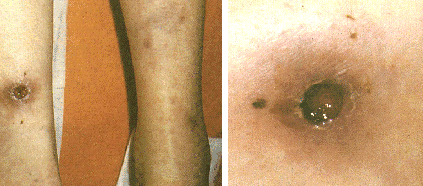Pyoderma Gangrenosum
 Pyoderma gangrenosum is characterized by relatively indolent ulcers with
extensive necrosis around the edges of the lesions. The ulcers are generally
on the lower extremities. While pyoderma gangrenosum may be an isolated
finding, it is most often associated with ulcerative colitis or Crohn's
disease.
Pyoderma gangrenosum is characterized by relatively indolent ulcers with
extensive necrosis around the edges of the lesions. The ulcers are generally
on the lower extremities. While pyoderma gangrenosum may be an isolated
finding, it is most often associated with ulcerative colitis or Crohn's
disease.
The ulcers have ragged bluish-red overhanging edges and a necrotic base.
The lesions often start as pustules or tender nodules at the site of trauma,
and then they gradually increase in size until liquefaction necrosis occurs
and an irregular ulcer develops.
The ulcers are often multiple and may cover large areas of the leg.
Histopathologic findings are non-specific. Healing tends to parallel the
activity of the underlying inflammatory bowel disease, and scarring is
relatively common.
Patients with PG usually describe the initial lesion as a bitelike reaction,
with a small, red papule or pustule changing into a larger ulcerative lesion.
Often, patients give a history of a brown recluse or other spider bite,
but they have no evidence that a spider actually caused the initial event.
Classic PG is characterized by a deep ulceration with a violaceous border
that overhangs the ulcer bed. The lesions of PG most commonly occur on the
legs, but they may occur anywhere on the body
The prognosis of PG is generally good; however, recurrences may occur,
and residual scarring is common.
Many patients with PG improve with initial immunosuppressive therapy
and require minimal care afterwards; however, many patients follow a
refractory course and multiple therapies fail. These patients pose a
difficult clinical problem that requires frequent follow-up and long-term care.
MORE INFO: Pyoderma gangrenosum is marked by pus in the skin associated
with deep ulcerations. Like erythema nodosum, pyoderma gangrenosum is most
often found on the shins or ankles but sometimes on the arms.
Beginning as small blisters, these lesions eventually join together and form
into deep, chronic ulcers. Again, this disorder is somewhat more common among
people with ulcerative colitis (5 percent) rather than those with Crohn's
disease (one percent). Pyoderma gangrenosum often follows a similar course
to the pattern of the IBD itself, and may heal as the symptoms of IBD are
brought under control. Antibiotics, injections of medications into the ulcers
themselves, and topical ointments all may be used as treatment. Drug Reactions
Sometimes a skin disorder is a result not of the IBD itself, but rather of the treatment used to address the IBD. For instance, one of the mainstay medications in both Crohn's disease and ulcerative colitis is sulfasalazine -- a drug that may produce an allergy-type skin rash in some people. The reaction is attributed to the sulfa component in this agent, and newer medications -- including mesalamine (Asacol®, Canasa®, Pentasa®, Rowasa®), balsalazide (Colazal®), and olsalazine (Dipentum®) -- are similar to sulfasalazine but are manufactured without the sulfa ingredient. Steroids, another frequently used class of drugs in IBD, may also cause skin problems when used on a long-term basis. These include stria or stretch marks, thinning of the skin, aggravation of acne, facial puffiness, ankle swelling, and slow wound healing.
On behalf of learning, and use as teaching tools for those of us who need to
know about our disease, I have tried to supply you with as much information as
I could find on all of the drugs, treatments and disorders associated with
Inflammatory Bowel Diseases. I have tried to blend all facts supported by research
and also from personal experiences of other IBD sufferers into one readable webpage, and any and all information presented here is not entirely
from one source. Most information contained within these pages is found in the public domain.
At times you may find information used from another site, and as with all copyrighted materials you may find on these pages, I claim fair use under sections 107 through 118 of the Copyright Act (title 17, U.S. Code). Click here for more info
|
side links
- Achieve health, fitness, relaxation, and balance with
Wai Lana Yoga

|
 My Story
My Story  Please Help
Please Help  Shopping
Shopping  Insurance
Insurance
 Bad Credit? Click Here get credit!
Bad Credit? Click Here get credit!  Video Games from $7.99!
Video Games from $7.99!  Free Arts and Crafts Patterns
Free Arts and Crafts Patterns  Tarot
Tarot